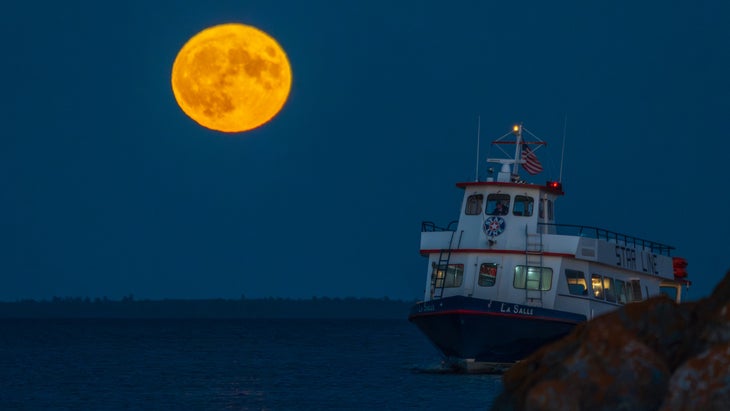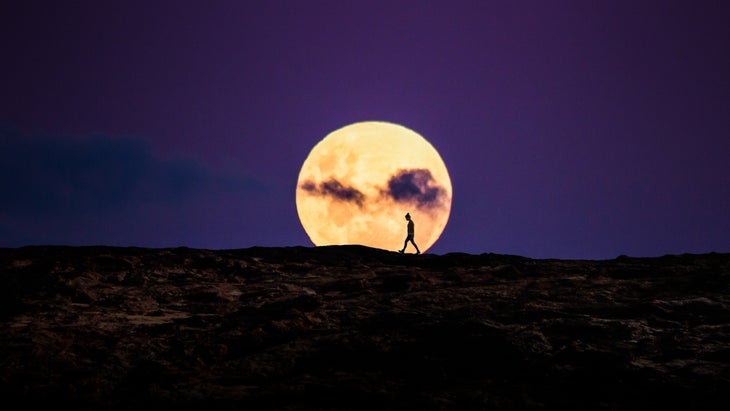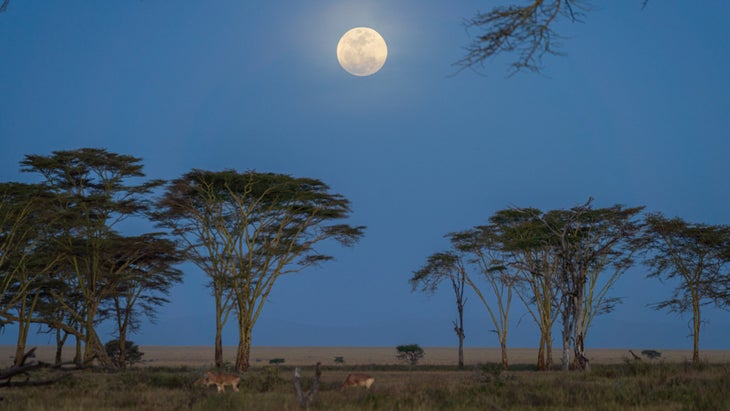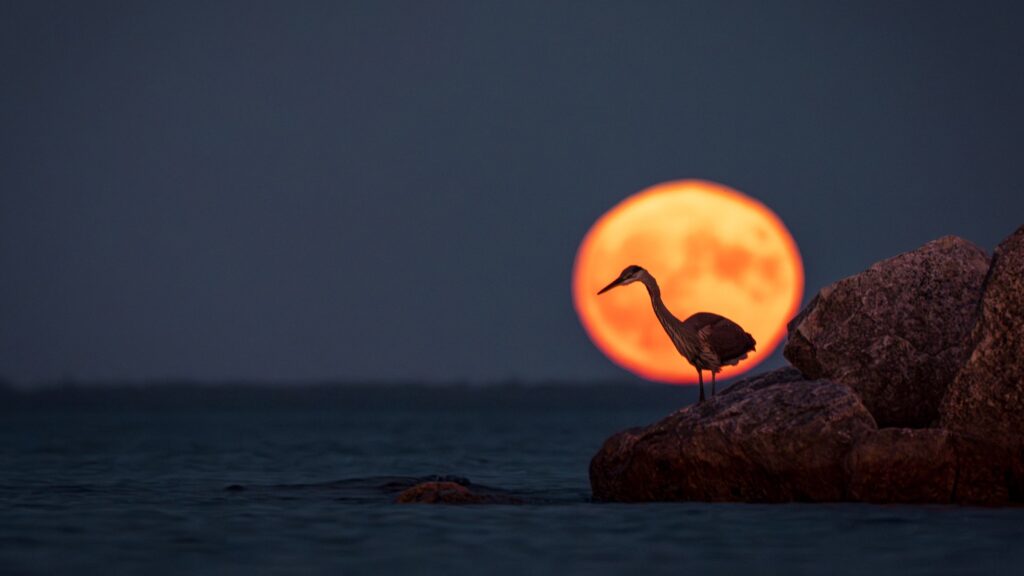A heron in front of a supermoon from Mackinac Island, Michigan (Photo: Stephanie Vermillion)
Published October 1, 2025 03:12AM
On Monday, October 6, the year’s first full supermoon will adorn the night sky. To admire it at its biggest and brightest, you’ll have to do more than just look up.
The spectacle occurs when the full moon is in its closest approach to Earth. During this period, the lunar orb can look up to 30 percent brighter and 14 percent larger than when it’s far from our planet. (At the latter phase, it’s known as a “micromoon.”)
The magnitude figures sound striking, but there is a catch. When you’re gazing high in the sky, a supermoon doesn’t seem all that much grander than your typical full moon. But it does seem gargantuan if you take advantage of my favorite trick: the moon illusion.

How to Get the Best Supermoon View
When the moon hangs near the horizon, it looks exceptionally large and luminous—but that’s just a trick of the eyes. It’s known as the moon illusion.
According to NASA, the space rock’s size stays constant as it travels through our skies. Yet when it rises and sets, it’s shocking enough to stop spectators in their tracks, especially when it’s a larger-than-average supermoon. Researchers haven’t confirmed how the mind game works, only that it does—and that’s good enough for me.
I plan all of my lunar photography shoots around the moonrise. Not only does the disk appear huge to the naked eye (and to my camera), our crater-pocked neighbor also looks more golden and even orange-tinged along the horizon due to how light wavelengths scatter.
When Is the Next Supermoon?
The first full supermoon of 2025 will occur on October 6. It reaches its peak fullness at 11:47 P.M. EDT; when you watch, keep an eye out for Saturn just to the rock’s right.
Next up: the full beaver moon—the closest and therefore largest of the year—will occur around 8 A.M. EST on November 5. At this time, the orb’s just 221,817 miles from us; that’s roughly nine spins around the globe. December 4 will conclude 2025’s supermoon trifecta. The full cold moon will occur at 6:14 P.M. EST.
You can see the bright sphere all night, but to capitalize on the moon illusion, head out around golden hour on the night before and of the official full moon. During the latter, it rises before sunset. On the true full moon night, it rises right around sundown.

Apps like SkySafari or Stellarium can help you plan your sky-watching timing, and tools like Photopills can help you research lunar alignments to nail that perfect moonrise or moonset shot—and that brings up an important point:
Most Moon Photos Suck. Here’s How to Take a Good One with Your Phone.
As countless memes show, it’s tough to take a solid moon photo with your smartphone. That’s because, while it looks spectacular to the naked eye, the full moon is just a blurry, overly bright dot when using the phone’s standard wide-angle lens.
Instead, try zooming in, then bringing down the exposure so you capture surface details, like craters. The view turns even more dramatic when you have a distant object in front of or near the moon, such as a lighthouse, mountain peak, or bird. (The farther the object, the greater the drama.)
Of course, the quality of your moon photo will depend on your smartphone’s camera capabilities. If you really want to up the ante, this $200 kit can make your iPhone work more like a DSLR. Or, you can invest in a mirrorless or DSLR camera with a telephoto lens.

Where to See the 2025 Supermoons
To spot the supermoon at its most magical, you’ll need a nice, clear view toward the eastern horizon. I’ve scoured Google Earth and my own camera roll to pinpoint ten geographically dispersed viewpoints with stellar scenery and solid east-facing views. Know this, though: you don’t have to travel far to see this space sight. Weather-permitting, it’s visible even in the most light-polluted cities and suburbs.
Death Valley National Park, California
Most stargazers plan their Death Valley trips around the new moon—it’s the best time to see the Milky Way—but the area dazzles beneath a supermoon, too. Watch from Zabriskie Point, a popular sunrise overlook with otherworldly badland views. Or climb up the Mesquite Flat Sand Dunes to watch the glowing globe shoot above the Grapevine and Funeral Mountain peaks.
Historic Columbia River Highway, Oregon
Motor along the Historic Columbia River Highway, particularly near the Vista House viewpoints, and gaze east to catch the dramatic supermoon rising above the rich green gorge. You’ll find several other viewpoints along this scenic road, as well as waterfalls galore. Detour to 620-foot Multnomah Falls while you’re here.
Badlands National Park, South Dakota
For a surreal supermoon scene, watch the bright ball rise over Badlands National Park in South Dakota. The park’s Big Badlands Overlook peers east, where the moon will climb above a sea of striated crag. Or, hit the Door Trail to watch the wonder among the maze of rock.
Grand Marais, Minnesota
Northern Minnesota is a great place for lower 48 aurora hunting, and Grand Marais is especially primed for supermoon views, too. From Artist’s Point, a popular sunrise hangout near downtown, watch the scene unfold over East Bay. Alternatively, partake in Great Lakes sauna culture by cozying up at Sisu and Löyly, a Nordic sauna experience with lake (and full-moon) views.
Arches National Park, Utah
Moab is like a playground for supermoon chasers. You can spot it rising within North Window Arch (via the Windows Loop Trail) or soaring above the Windows section at Arches National Park. For another glimpse, head to the east-facing lookouts, like Mesa Arch and the Grand View Point Overlook at Canyonlands National Park.
Saguaro National Park, Arizona
Watch the supermoon meet towering cacti at Saguaro National Park in Tucson. The Wild Dog Trail in the park’s western stretch peers east across a patchwork of saguaros and scrub. Nearby Signal Hill takes you even higher above the moonlit desert. Don’t miss other night-sky stops on the stargazing-focused Tucson Astro Trail on your visit.
Driftwood Beach, Georgia
Watch the moon inch above the sea and sun-scorched timber at Driftwood Beach on Jekyll Island in Georgia’s Golden Isles. This beloved sunrise spot allures nature lovers with east-facing panoramas that delight during supermoon season. Don’t be surprised if dolphins or pelicans photobomb your moon snap, too.
Padre Island National Seashore, Texas
Padre Island National Seashore spans nearly 70 miles of paradisiacal Texas coastline, with stellar birding, beachcombing, and, starting October 6, supermoon watching. Catch the lunar spectacle from spots like North, Closed, or South Beaches. Or, snag a sandy campsite to enjoy the moon’s close approach, with a crashing-waves soundtrack, all night.
Liberty State Park, New Jersey
Liberty State Park, set in Jersey City, New Jersey, looks east across the Hudson River. From here, spot the supermoon clearing the Lower Manhattan skyline, or Ellis Island and Brooklyn. And enjoy the Statue of Liberty’s golden-hour glow from the park’s scenic two-mile Liberty Walk before you leave.
Geneva Lake, New York
From the western side of Geneva Lake, spectators can admire the supermoon climbing above the Finger Lakes and reflecting off the glassy waters. Public access options abound on the northwest shoreline, including at the Finger Lakes Welcome Center and along the waterfront trail.


